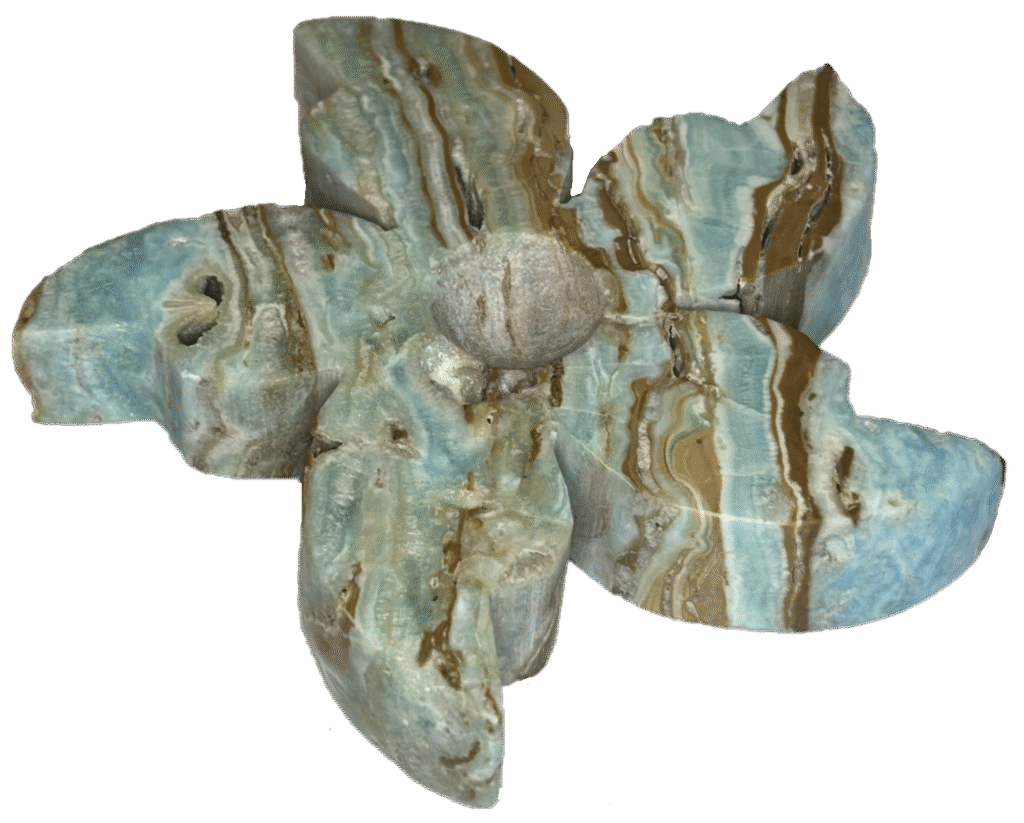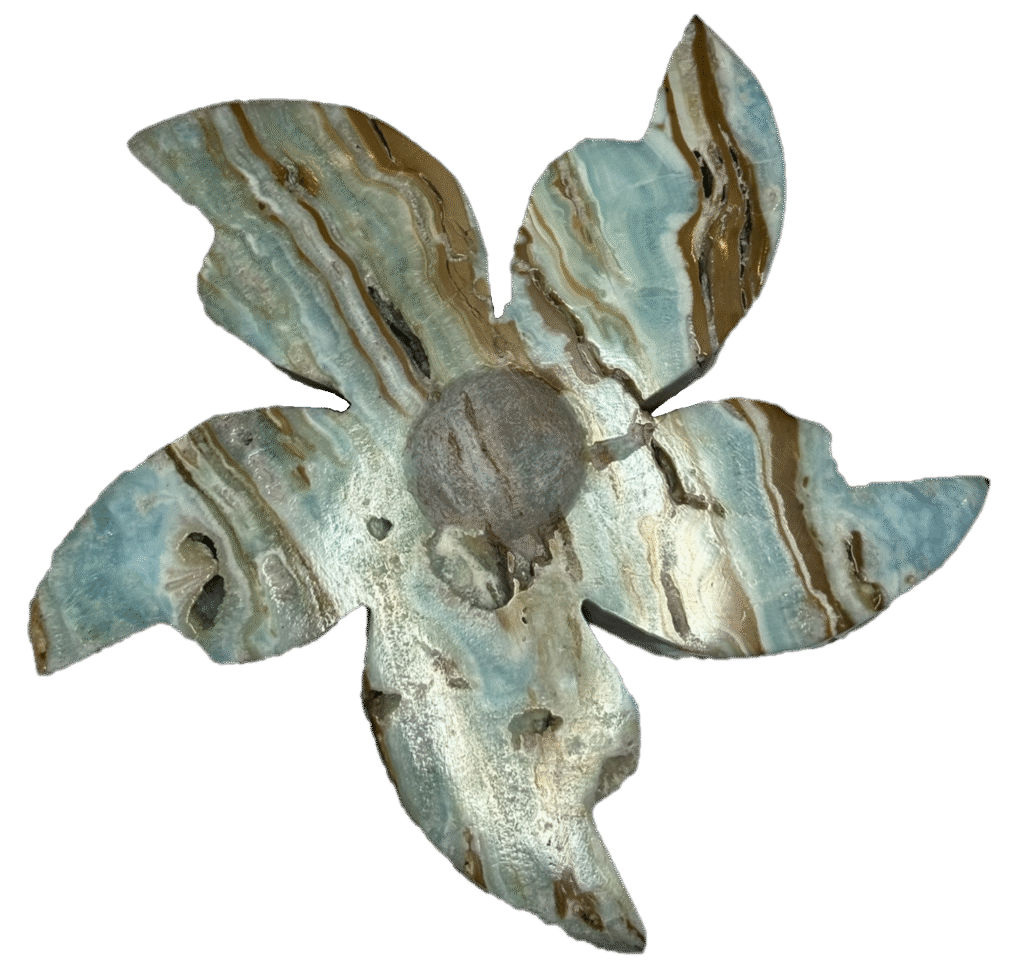
Blue Aragonite derives its name from the Spanish region of Aragon, where it was first discovered in the 18th century. The name was officially given by Abbé René Just Haüy, a French mineralogist, in recognition of its origin.
Alternate Names:
- Ocean Aragonite – Due to its resemblance to the colours of tropical waters.
- Aqua Aragonite – Highlighting its soft blue to turquoise shades.
- Sky Aragonite – A name inspired by its sky-like hues.
Composition and Physical Characteristics
Blue Aragonite is a calcium carbonate mineral (CaCO₃) that forms in sedimentary and hydrothermal environments. It is chemically identical to calcite but crystallises in the orthorhombic system, giving it distinct structural properties.
Physical Properties:
- Chemical Formula: CaCO₃
- Crystal System: Orthorhombic
- Hardness: 3.5 – 4 on the Mohs scale
- Lustre: Vitreous to silky
- Transparency: Transparent to translucent
- Streak: White
- Fracture: Brittle, conchoidal
- Cleavage: Distinct
Varieties of Blue Aragonite
- Pure Blue Aragonite – Found in pastel blue tones, often translucent.
- Blue-Green Aragonite – Contains hints of green, influenced by trace elements.
- Botryoidal Blue Aragonite – Forms in rounded clusters, resembling coral formations.
- Fibrous Blue Aragonite – Displays silky, radiating structures.
Locations and Notable Finds
Blue Aragonite is relatively rare and can be found in:
- Spain – The original discovery site in Aragon.
- China – A major source of botryoidal and fibrous formations.
- Pakistan – Produces high-quality Blue Aragonite in varying shades.
- Morocco – Known for beautiful blue specimens with a fibrous structure.
- Peru – Yields distinctively translucent blue formations.
Archaeological and Significant Finds
While not widely used in ancient artefacts, Aragonite has been identified in:
- Egyptian Jewellery – Small carvings and amulets.
- Roman and Greek Art – Occasionally used in decorative pieces.
- Medieval Europe – Found in religious relics and mosaics.
Historical and Current Usage
Historical Uses
- Sculptures and Beads – Used in small decorative objects.
- Healing Amulets – Worn as a talisman for calmness.
- Spiritual Artefacts – Occasionally crafted into sacred objects.
Modern Uses
- Jewellery – Made into cabochons, beads, and pendants.
- Crystal Healing – Popular in holistic and metaphysical practices.
- Decorative Pieces – Used for carvings and ornamental objects.
Interesting Facts
- Blue Aragonite fluoresces under ultraviolet light, emitting a soft glow.
- It is one of the three main forms of calcium carbonate, alongside calcite and vaterite.
- Some Blue Aragonite deposits are millions of years old, forming in ancient seabeds.
- It is structurally fragile and often stabilised for use in jewellery.
Folklore, Legends, and Tales
- The Ocean’s Voice – Ancient sailors believed Blue Aragonite carried the whispers of the sea.
- The Stone of the Sky Gods – In some traditions, it was thought to be a gift from celestial beings.
- The Soothing Gem – Used in medieval healing rituals to ease heartache and grief.
Mystical Healing Properties
Blue Aragonite is regarded as a stone of emotional healing, communication, and inner peace.
Healing Benefits:
- Encourages Soothing Energy – Helps calm stress and anxiety.
- Enhances Communication – Especially beneficial for emotional expression.
- Aids Spiritual Growth – Supports meditation and intuition.
- Promotes Self-Compassion – Encourages understanding and self-acceptance.
- Supports Physical Healing – Traditionally used for throat-related issues.
Astrological and Zodiac Connections
Blue Aragonite resonates with several zodiac signs:
- Pisces – Enhances emotional depth and intuition.
- Cancer – Promotes inner peace and self-nurturing.
- Capricorn – Encourages patience and balance.
Chakra System Connections
Blue Aragonite is deeply linked to the Throat Chakra (Vishuddha), enhancing communication and truth-speaking.
- Clears blockages in self-expression.
- Strengthens intuitive and spiritual awareness.
- Helps with emotional release and clarity.
Birthstone and Wedding Anniversary Links
Wedding Anniversary – Associated with the 19th wedding anniversary, representing harmony and communication in relationships.
Birthstone – Considered an alternative stone for March, symbolising clarity and emotional balance.

Blue Aragonite
Calming and heart-opening, Blue Aragonite soothes emotional wounds and encourages empathy. A gentle stone for healing, communication, and inner peace.
